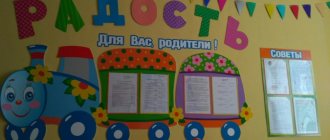Practice using the information block for parents on lexical topics.
The problem of organizing correctional work to overcome speech impairment in preschool children (5-6 years old) with such a type of speech pathology as underdevelopment of the lexico-grammatical structure is relevant, in our opinion, because lexico-grammatical operations for generating speech are extremely complex and involve a fairly high level of development of analytical and synthetic activities.
To increase the effectiveness of correctional influence, we consider the need for integrated work in the interaction of all subjects of educational activity: speech therapists, educators, parents, physical education instructor, music director, art teacher.
An integrated approach to overcoming a speech defect involves the active participation of parents, who consolidate all the speech skills and abilities of children acquired in kindergarten in everyday life.
The purpose of the pedagogical experience: to create in kindergarten the necessary information block of complex correctional work to overcome lexical and grammatical speech disorders in preschool children (5-6 years old).
This system of work has been used in the work of speech therapists at the MADOU “Kindergarten No. 395” of the city of Perm A. F. Buzmakova, E. G. Bugrova for 15 years, has a positive expert opinion from Art. Researcher at the Laboratory of Special Education of PKIPKRO E. E. Ayupova.
Speech therapy corner as part of a subject-development environment in a preschool group
In preschool age, a very pressing problem is the problem of speech in all its diversity. There are many techniques that allow you to regulate the process of speech development in children. The most important condition for improving the speech activity of preschoolers is the creation of an emotionally favorable situation that promotes the desire to actively participate in verbal communication.
The development of a preschool child is greatly influenced by the space around him, the environment in which he spends most of the time. A subject-based developmental environment makes it possible to enrich the experience of a child’s emotional and practical interaction with peers and the teacher, and to include all children in groups in active cognitive activity. The subject-development environment includes a correctional corner in the group. It is a specially equipped space for playing alone or in small groups. Its equipment includes shelving, a mirror, gaming, didactic and visual material. With their help, educators create conditions for correcting deviations in the development of children, stimulating speech activity and verbal communication. The content is determined not by chance, but in strict accordance with the program, physiological and psychological-pedagogical features of speech formation.
Didactic equipment must correspond to the structure of children’s speech disorders, their individual and age characteristics. Only with this approach is it possible to effectively correct the speech of preschool children. An integral attribute of the speech corner should be a toy - an “animate character” that helps solve such important correctional problems as overcoming uncertainty, shyness, achieving emotional stability, self-regulation, arousing speech interest in children, and encouraging speech activity.
It is advisable to locate the correction corner in a well-lit place and somewhat distant from the playing area. This will create more comfortable conditions for studying there. Access to the corner should be convenient so that children can approach it themselves and study. If there is insufficient lighting, additional lighting must be provided.
The occupancy of the speech therapy corner in groups is carried out according to sections:
‒ articulation gymnastics in pictures: (pictures for articulation exercises, sets of exercises for articulation in pictures-tables).
- fine motor skills: tops, dry pool, lacing, stencils, etc.;
- breathing: pinwheels, pipes, balloons, bubbles, air flow games, etc.;
‒ phonemic awareness: games for differentiating sounds
‒ sound pronunciation: albums on sound automation, game exercises, games on sound automation: “Speech therapy lotto”, etc.
‒ vocabulary: pictures reflecting the lexical topic being studied (plot and subject); educational puzzles, games: lotto, “Pick a Pair”, “Who Can Name More”, “Part and Whole”, etc.;
‒ grammatical structure of speech: games “Whose tail?”, “One is many”, “Call it affectionately”, “What’s missing?” and etc.;
‒ coherent speech: plot pictures, “Guess by the description”, “When does this happen?”, “We play in the profession”, etc.;
‒ literacy: diagrams of words, sentences, games: “Match a word to a diagram”, “Make a sentence according to a diagram”, “Add a word”, etc.
Game and didactic material is replaced and replenished in the correctional corner weekly, depending on the lexical topic. It is necessary to diversify the activities of children in the correctional corner. Didactic equipment must meet the needs of the child’s current, immediate development and self-development. You should not overload the corner with equipment, as this makes selection difficult. But it is necessary to take into account that even an empty subject space tires and encourages idleness and aggression. Relying on play as the leading activity of preschoolers provides teachers with a significant positive effect in correctional work.
The selection of gaming and didactic material is carried out jointly by the speech therapist and the teacher, which makes their interaction not formal, but very close and fruitful. The material contained in the correction corner should be multifunctional, making it possible to use it for different purposes.
When creating a group correctional corner, it is very important that the environment surrounding the children is comfortable and aesthetically pleasing. Its design should be attractive to children and arouse their desire for independent activity. At the same time, it is necessary to teach children to maintain order in the corner and cultivate a caring attitude towards toys.
Thus, the use of a correctional corner allows you to expand the speech environment in the group, create in children emotional responsiveness and a desire to participate in verbal communication with adults and independently, during the game, easily and naturally develop and improve their speech skills.
Literature:
- Artamonova O. V. Subject-spatial environment: its role in personality development // Preschool education.-2005-No. 4
- Konovalenko V.V. Corrective work of a teacher in a preparatory speech therapy group - St. Petersburg, GNOM and D, 2009.
- Nishcheva N.V. Subject-spatial developmental environment in kindergarten, N.V. Noscheva.-St. Petersburg: Childhood-Press, 2006.
- Stepanova O. A. Organization of speech therapy work in preschool educational institutions.-M., 2007.
The information equipment of the speech therapist's corner for parents includes several sections:
— expansion of vocabulary, enrichment of the active vocabulary.
For each lexical topic, an approximate vocabulary for the entire week is indicated, a circle of words is outlined that all specialists and parents, under the guidance of a speech therapist, will introduce into the active speech of children. This ensures the quickest actualization of new words for children.
— formation of lexical and grammatical means of language and development of coherent speech: lexical and grammatical games and exercises.
— development of fine and gross motor skills, coordination of speech with movement: finger and articulation gymnastics, outdoor games.
— development of phonemic, phonemic analysis and synthesis of words, phonemic representations;
— improvement of spatio-temporal orientations;
— development of constructive praxis;
- development of thinking, memory, attention.
Educational program for parents
Articulation gymnastics for children 3-18 months Children with speech disorders
Dysgraphia
- mechanism and forms of dysgraphia, advice to parents, exercises to help overcome dysgraphia
How to Help Your Child Remember to Spell Dictionary Words
Dyslexia
- forms and causes of dyslexia, basic techniques and methods of working with dyslexic children, texts of visual dictations, tests to determine dyslexia for adults.
Dysarthria (detail)
- causes of dysarthria, main directions of correctional work, exercises, techniques, where to go for help
Dysarthria, erased form of dysarthria (briefly)
Hyperactivity and disinhibition
Alalia, ONR, ZRR, MDD
Stuttering
- causes and symptoms of stuttering, methods of overcoming stuttering, rules and exercises, practical advice, where to go for help
Mutism
- a little history, clinical variants of mutism, treatment of mutism, recommendations on where to go for help
Rhinolalia
- forms of rhinolalia, elimination of rhinolalia, gymnastics, exercises, where to go for help
Bradylalia
- symptoms, methods of speech therapy, recommended exercises, where to go for help
How are Caesar babies different from naturally born children?
How to get rid of interdental sounds?
Speech development of children 4-7 years old
Speech therapy homework on the formation of the lexical and grammatical structure of speech and the development of coherent speech
Preface
SEPTEMBER
- Week 1 Vegetables
- Week 2 Fruits
- 3rd week Garden
- Week 4 Where did the bread come from?
OCTOBER
- 1st week Trees
- Week 2 Mushrooms
- 3rd and 4th week Autumn
NOVEMBER
- 1st and 2nd week Wild animals of our forests and preparing them for winter
- 3rd and 4th week Pets
DECEMBER
- 1st and 2nd week Poultry
- 3rd and 4th week New Year. Christmas decorations
JANUARY
- 1st week Christmas
- Week 2 Winter fun
- Week 3 Wintering birds
- 4th week Winter (summary)
FEBRUARY
- 1st week Dishes
- 2nd week Transport. Traffic rules
- 3rd week Defender of the Fatherland Day
- Week 4 My family
MARCH
- 1st week March 8th - mother's holiday
- 2nd week Professions
- 3rd and 4th week Migratory birds
APRIL
- 1st week Early spring
- 2nd week Cosmonautics Day
- 3rd week Easter
- Week 4 Furniture
MAY
- 1st week Repetition
- 2nd week Victory Day
- 3rd week Spring. Primroses
- Week 4 Insects
JUNE
- 1st week Spring (recap)
2nd week Summer homework
See also: Themed walks
Material for the speech therapist’s corner “Advice for parents”
“A good, clear pronunciation of a word, such that each of the sounds that make up the word is heard, and a sensitive ear in distinguishing these sounds - these are the main foundations of spelling.”
Ushinsky K.D.
Memo for parents
Dear parents!
You dream that your child will be healthy, capable, smart and literate!
We invite you to achieve what you want together with a speech therapist.
To do this, you must always follow simple rules, namely:
- You need to exercise daily for 10–15 minutes.
- Carry out the tasks of the speech therapist in a playful way.
- Even for small successes, a child should always be rewarded.
- In everyday involuntary activities, do not forget about the goal and pay the child’s attention to both his own speech and the speech of those around him.
- Pure sayings, proverbs, riddles, poems, fairy tales, stories and retellings help to reinforce the given sounds.
- Pay attention to your own speech: speak slowly, measuredly and clearly.
Remember: Your speech is an example for the child.
- Avoid mimicking or ridiculing your child’s speech.
- Try to follow all the recommendations of the speech therapist, including visits to specialized specialists (neurologist, audiologist, ophthalmologist, otolaryngologist, etc.) as recommended by the speech therapist.
- See a speech therapist as soon as requested.
If these requirements are not met, the school teachers will raise the issue of removing the child from speech therapy classes.
Remember, big victories come from small victories!
MAYBE YOUR CHILD NEEDS A Speech Pathologist OR Speech Pathologist?
Pay attention to your child's speech. Is something bothering you? Consult a specialist. He will dispel your doubts, and if necessary, he will suggest the most suitable way for your child to solve the problem. Do not put off visiting a speech therapist for too long, otherwise the favorable time may be irretrievably lost.
IS YOUR ADMISSION TO 1ST GRADE SOAR?
For a child to successfully study at school, the following skills and abilities must be developed by the end of preschool age:
1. Correct pronunciation and distinction of sounds.
2. Competent presentation of your own thoughts.
3. Active development and replenishment of vocabulary.
4. The ability to distinguish the semantic meaning of words.
Unfortunately, at present, most children have insufficient development of these skills, which is why a lot of problems arise with teaching a child to read and write in elementary school. SEEK A Speech-Language Pathologist OR Speech Pathologist for Consultation.
Speech therapist's advice to parents
IF YOUR CHILD STARTS TO “STUMPER” IN SPEECH, CONTACT A NEUROLOGIST IMMEDIATELY.
IF YOUR CHILD HAS BEEN DIAGNOSED WITH “LOGONEUROSIS” OR “STUTTERING,” THEN YOU SHOULD BE SURE TO FOLLOW THE FOLLOWING SIMPLE RULES:
1. You should not finish words or thoughts for your child; wait until he says everything himself.
2. Try not to hide your eyes, but maintain visual contact with the child.
3. Set the tone in your speech: speak calmly, smoothly. The child will try to speak the same way.
4. Talk to your child without being distracted by other things.
5. Create a calm, positive environment around the child, exclude any traumatic situations, prolonged viewing of videos, etc.
6. Never criticize or punish a child for incorrect or slurred speech.
7. If your child is interested in the issue of stuttering, do not be afraid to talk about it openly.
8. Follow your doctor’s orders and speech therapist’s advice.
DOES YOUR CHILD NEED A Speech Therapist?
YES if:
-
Your child is reluctant to talk and is more silent;
- incorrectly pronounces sounds in words;
- has problems understanding your speech;
-distorts the syllabic structure of a word (locomotive - pavoz, etc.);
- has a low vocabulary;
- cannot talk coherently about anything;
- the child has a nasal tone of voice, regularly repeated hesitations in speech, or blurred, unclear speech that is incomprehensible to others.
If at least one point is present, then there is cause for concern and seeking advice from a speech therapist. Don't put off solving the problem for too long. Time may be lost forever!
DEVELOPING A CHILD'S SPEECH....IN THE KITCHEN
Don't have time to study with your child? Need to cook dinner? Then these tips are for you!
You cook, and your baby plays nearby, or rather, he “helps.” By developing a child's fingers, we develop his speech.
1. Game "Cinderella". Pour peas and rice or beans and buckwheat into a plate and let the baby separate them into two piles.
2. If you spread a thin layer of plasticine on a piece of cardboard, then with the help of the same cereal the child will be able to lay out an image of some object. You will get an applique of cereals.
3. Allow your child to play with raw pasta. They come in different shapes and sizes. Pasta can be laid out in various patterns or strung on a thread to make beads for mom.
You can also play word games.
1. “What do you need for borscht?” The child names all the foods and vegetables. To make the game fun, you can name those products from which borscht is not cooked.
2. “Name the pieces of furniture” (dishes, all fruits, all flour or dairy products).
3. “What is needed for what?” Purpose of different kitchen utensils.
4. “Guess what it is?” Name the characteristics of the object (white, cold, sweet - ice cream, etc.)
By using your imagination, you can help your child explore the world and develop speech.
Mistakes parents make when teaching children to read
Do you want to teach your child to read? Then do it right! Don't make mistakes, the consequences of which have to be corrected with great difficulty.
When showing a letter, we call it like a sound. For example, the letter C, not ES. We learn to distinguish this sound, find it in words, and come up with words with this sound. ES is already 2 sounds and when reading the syllable SA, the child will read ES. Avoid "talking" alphabet. It is voiced by non-professionals.
Teach fluid reading, not individual letters (letter-by-letter reading). For example, we correctly pull SSSSAAAAAA, and not C, A - SA. First we teach syllabic reading, then gradually move on to reading whole words.
We often hear: “He can’t pronounce the letters.”
Attention! We pronounce and hear SOUNDS, and we see and write letters!




